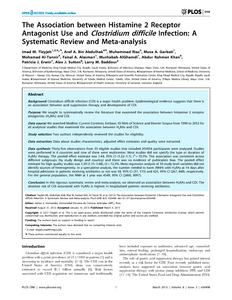Tleyjeh, IM;
Abdulhak, AB;
Riaz, M;
Garbati, MA;
Al-Tannir, M;
Alasmari, FA;
Alghamdi, M;
Khan, AR;
Erwin, PJ;
Sutton, AJ;
et al.
Tleyjeh, IM; Abdulhak, AB; Riaz, M; Garbati, MA; Al-Tannir, M; Alasmari, FA; Alghamdi, M; Khan, AR; Erwin, PJ; Sutton, AJ; Baddour, LM
(2013)
The association between histamine 2 receptor antagonist use and Clostridium difficile infection: a systematic review and meta-analysis.
PLoS One, 8 (3).
e56498 -e56498 (16).
https://doi.org/10.1371/journal.pone.0056498
SGUL Authors: Riaz, Muhammad
![[img]](https://openaccess.sgul.ac.uk/105261/1.hassmallThumbnailVersion/pone.0056498.pdf)  Preview |
|
["document_typename_application/pdf; charset=binary" not defined]
Published Version
Download (967kB)
| Preview
|
Abstract
Background
Clostridium difficile infection (CDI) is a major health problem. Epidemiological evidence suggests that there is an association between acid suppression therapy and development of CDI.
Purpose
We sought to systematically review the literature that examined the association between histamine 2 receptor antagonists (H2RAs) and CDI.
Data source
We searched Medline, Current Contents, Embase, ISI Web of Science and Elsevier Scopus from 1990 to 2012 for all analytical studies that examined the association between H2RAs and CDI.
Study selection
Two authors independently reviewed the studies for eligibility.
Data extraction
Data about studies characteristics, adjusted effect estimates and quality were extracted.
Data synthesis
Thirty-five observations from 33 eligible studies that included 201834 participants were analyzed. Studies were performed in 6 countries and nine of them were multicenter. Most studies did not specify the type or duration of H2RAs therapy. The pooled effect estimate was 1.44, 95% CI (1.22–1.7), I2 = 70.5%. This association was consistent across different subgroups (by study design and country) and there was no evidence of publication bias. The pooled effect estimate for high quality studies was 1.39 (1.15–1.68), I2 = 72.3%. Meta-regression analysis of 10 study-level variables did not identify sources of heterogeneity. In a speculative analysis, the number needed to harm (NNH) with H2RAs at 14 days after hospital admission in patients receiving antibiotics or not was 58, 95% CI (37, 115) and 425, 95% CI (267, 848), respectively. For the general population, the NNH at 1 year was 4549, 95% CI (2860, 9097).
Conclusion
In this rigorous systematic review and meta-analysis, we observed an association between H2RAs and CDI. The absolute risk of CDI associated with H2RAs is highest in hospitalized patients receiving antibiotics.
| Item Type: |
Article
|
| Additional Information: |
Copyright notice
This is an open-access article distributed under the terms of the Creative Commons Attribution License, which permits unrestricted use, distribution, and reproduction in any medium, provided the original author and source are credited. |
| Keywords: |
Adolescent, Adult, Anti-Bacterial Agents, Case-Control Studies, Clostridium difficile, Enterocolitis, Pseudomembranous, Female, Histamine H2 Antagonists, Hospitalization, Humans, Male, Receptors, Histamine H2, Regression Analysis, Risk Factors |
| SGUL Research Institute / Research Centre: |
Academic Structure > Population Health Research Institute (INPH) |
| Journal or Publication Title: |
PLoS One |
| Related URLs: |
|
| Dates: |
| Date | Event |
|---|
| 4 March 2013 | Published |
|
| PubMed ID: |
23469173 |
| Web of Science ID: |
23469173 |
  |
Download EPMC Full text (PDF)
|
 |
Download EPMC Full text (HTML)
|
 |
Go to PubMed abstract |
| URI: |
https://openaccess.sgul.ac.uk/id/eprint/105261 |
| Publisher's version: |
https://doi.org/10.1371/journal.pone.0056498 |
Statistics
Item downloaded times since 31 Mar 2014.
Actions (login required)
 |
Edit Item |




